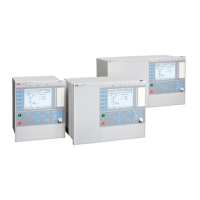1. Simulate normal operating conditions with the three-phase currents in phase with
their corresponding phase voltages and with all of them equal to their rated values.
2. Slowly decrease the measured voltage in one phase until the BLKV signal appears.
3. Record the measured voltage and calculate the corresponding zero-sequence voltage
according to the equation (observe that the voltages in the equation are phasors):
EQUATION1819-ANSI V1 EN (Equation 106)
Where:
EQUATION1820-ANSI V1 EN
are the measured phase voltages
4. Compare the result with the set value of the zero-sequence tripping voltage (consider
that the set value 3V0Pickup is in percentage of the base voltage.)
5. Repeat steps
1 and 2. Then slowly increase the measured current in one phase until
the BLKV signal disappears.
6. Record the measured current and calculate the corresponding zero-sequence current
according to the equation (observe that the currents in the equation are phasors):
ANSIEQUATION00019 V1 EN (Equation 107)
Where:
ANSIEQUATION00020 V1 EN
are the measured phase currents
7. Compare the result with the set value of the zero-sequence trip current. Consider that
the set value 3I0< is in percentage of the base current IBase.
11.9.2.4 Measuring the
trip
value for the dead line detection function
1. Apply three-phase voltages with their rated value and zero currents.
2. Decrease the measured voltage in one phase until the DLD1PH signal appears.
3. This is the point at which the dead line condition is detected. Check the value of the
decreased voltage with the set value VDLDPU (VDLDPU is in percentage of the
base voltage VBase).
1MRK 504 165-UUS - Section 11
Testing functionality by secondary injection
Transformer protection RET670 2.2 ANSI 233
Commissioning manual

